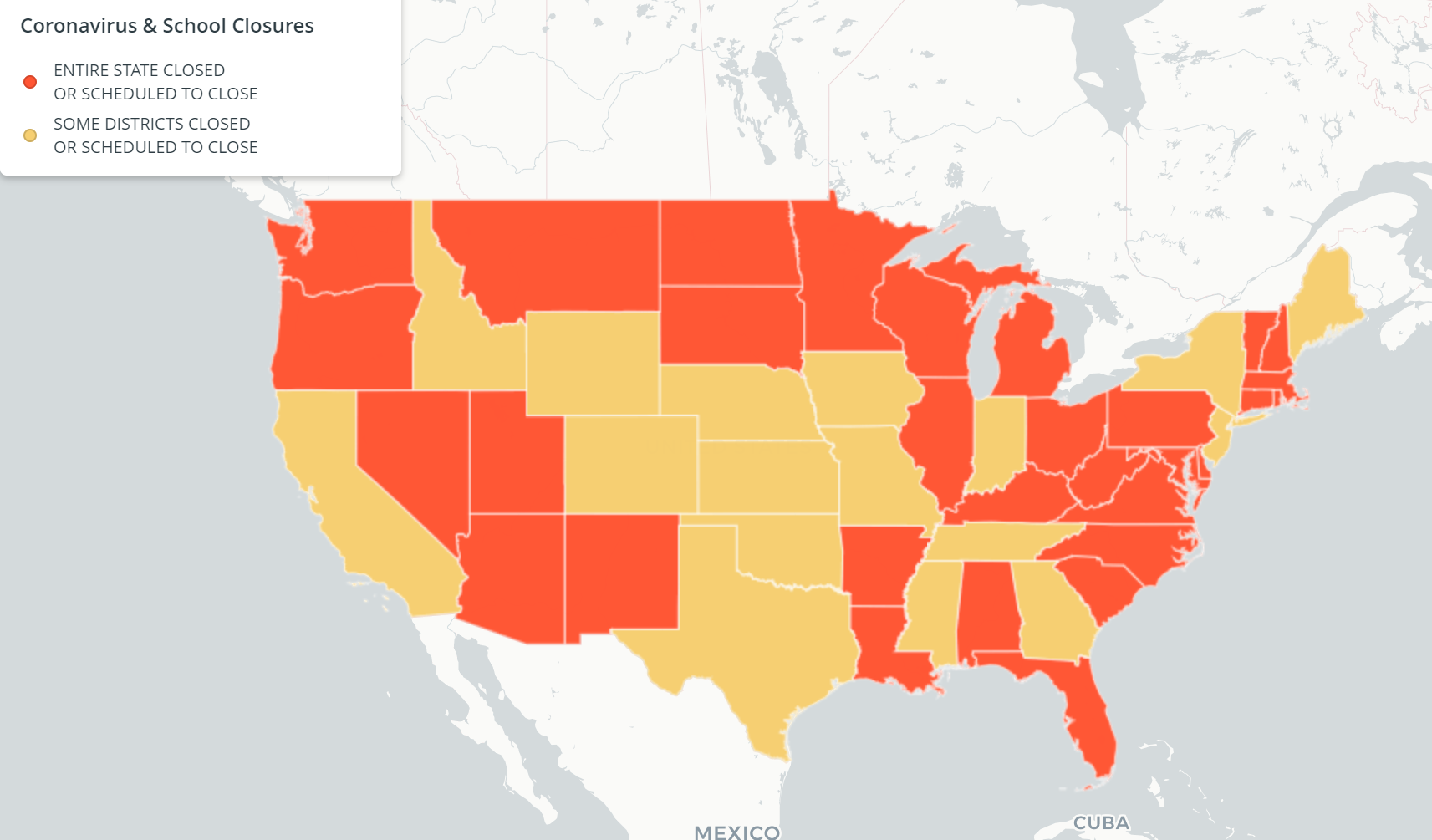Coronavirus and Missouri's Schools: What to know
Saint Louis University (SLU), alongside many other colleges and universities nationwide, has made the difficult decision to cancel in-person courses for the remainder of the 2020 spring semester. Instead, SLU and others will rely on virtual coursework to avoid the spread of the Coronavirus Disease 2019 (COVID-19), a respiratory illness that is spreading globally through person-to-person contact.
Similarly, school districts nationwide and throughout Missouri are also making changes and considering available options (see Ed Week’s map of current school district closures around the nation), including the nation’s largest school district in New York City. Media outlets have focused on how school closures might impact students and what we all might expect in the coming weeks and months.
Source: EducationWeek
Virtual Learning
Most educational institutions are implementing virtual learning to alleviate as much of the disruption in the school year as possible, given the circumstances. Virtual learning is a learning environment provided entirely through virtual modules. These can be recorded lectures, one-on-one video lessons, or content provided via online communication. Virtual learning has become the most prominent form of distance education as it is available to anyone with a suitable device and a broadband connection.
While the Centers for Disease Control (CDC) has recommended school closures only in places where they are necessary, they also suggested that districts plan for distance learning. Kansas City School District (KC 33) is one of the first major Missouri school districts to cancel districtwide events. Since KCPS’s announcement, St. Louis City--including all charter and private schools in the city--Jefferson County, and St. Charles County, and districts across St. Louis County have announced they will remain closed until at least early April. This situation is evolving quickly enough that the original draft of this piece nearly posted when KCPS was the lone closed district.
In order for virtual learning to work, students will need access to adequate broadband to allow internet access. Currently, Missouri ranks as the 41st most connected state in the U.S. The quality of coverage varies greatly by county, and while most Missourians have access to the internet, in many rural counties, only a small percentage of the population has access to necessary internet speed for virtual learning. Regardless of internet coverage, some students may lack a suitable technological device to participate in online learning.
In addition, students with Individual Education Plans (IEPs) may not be able to receive services and accommodations that are typically available in school. Further, research available suggests that virtual learning is a less effective method of instruction than in-person teaching. Overall, these unprecedented circumstances prompt questions on the equity of access to virtual education, and there are worries that existing inequality might be exacerbated by the emergency response of schools.
Nutrition
With school closures, there is a concern our most vulnerable students will be isolated from one of their main food sources. Currently, more than 30 million students in the U.S. participate in the National School Lunch Program and School Breakfast Program. In Missouri, approximately 900,000 people are struggling with hunger, and nearly 250,000 of them are children. One in 6 children in Missouri is struggling with hunger, and school lunches are a significant source of reliable food. So what will the outbreak of COVID-19 mean for those students who rely on their school for meals?
Fortunately, many officials are acting quickly to ensure concerns for public health don’t ignore students’ basic needs. The School Nutrition Association (SNA) sent a letter to the U.S. Department of Agriculture, asking “the agency to waive the requirements for congregate feeding and allow meals to be served at closed schools and community sites.” In response, the USDA announced new flexibility concerning how schools can feed students during unexpected closures and noted that “the law allows USDA the authority to waive the group setting meal requirement, which is vital during a social distancing situation.”
To ensure food security at the national scale, some members of Congress have introduced Maintaining Essential Access to Lunch for Students (MEALS) Act and the COVID-19 Child Nutrition Response Act to alleviate districts’ concerns in serving food to those students who rely on school meals. These bills would “allow school officials to serve meals in a variety of settings through a new nationwide waiver authority.” On Saturday, Congress passed the Families First Coronavirus Response Act which would provide a variety of services to those most adversely affected by shutdowns.
Meanwhile, the states of California and Washington already requested and were approved by the USDA to allow meal services during school closures. For example, the Northshore School District in Bothell, Washington, temporarily closed schools and began providing lunches to students and “grab and go” meals at 17 school sites. When districts in Missouri proactively or reactively close their schools, they may collaborate with local non-profit organizations or use their own available resources to serve students who are especially vulnerable at times like this.
Summary and Closing Thoughts
We are in uncharted waters. Many districts have extended break periods in order to assess options and provide additional time to make determinations about potential school closures. School closures also raise issues of equity around the availability of resources and may disadvantage those without access. Both the CDC and the Department of Elementary and Secondary Education (DESE) will continue to update information on COVID-19. Everyone is encouraged to monitor these resources and stay tuned to other national, state, and local government agencies on recommendations and requirements for education and beyond.






